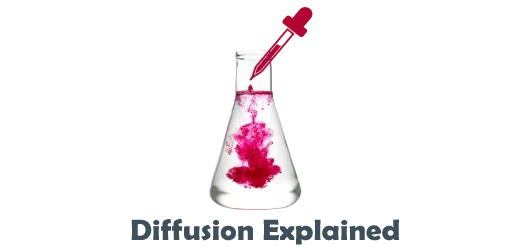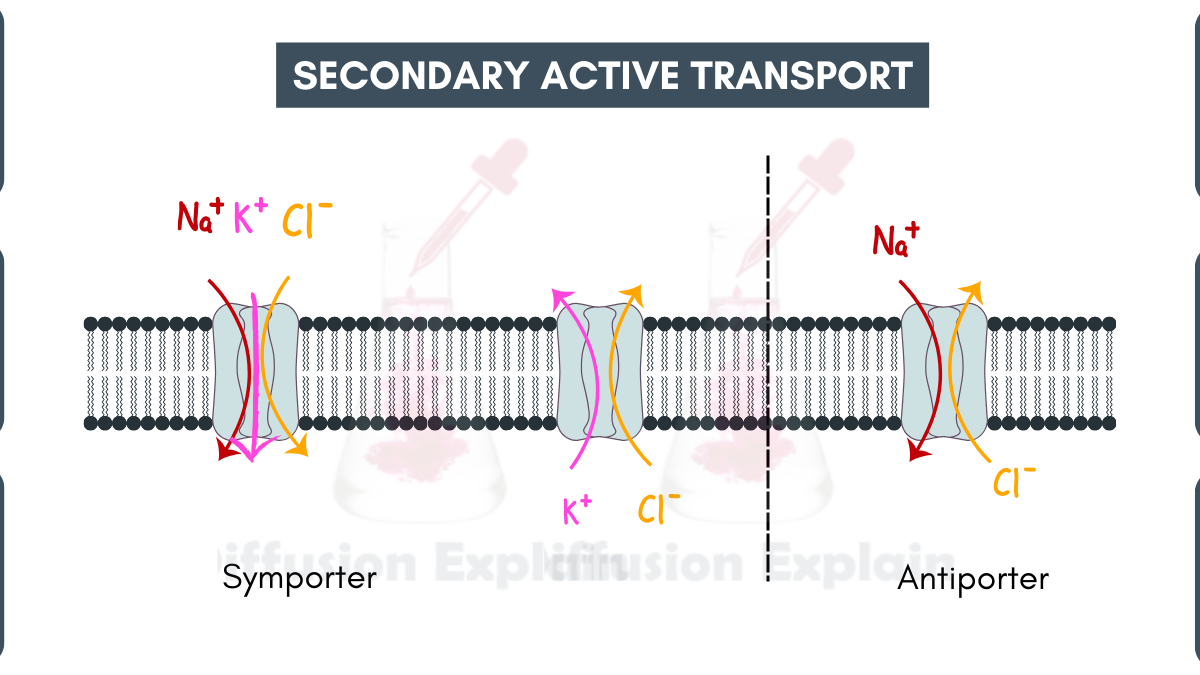What is Active Transport?
Active transport is a cellular process in which molecules or ions are moved across a biological membrane against their concentration gradient, from an area of lower concentration to an area of higher concentration. This movement requires the expenditure of cellular energy, typically in form of adenosine triphosphate (ATP).
Read How Active Transport is Different from Facilitated Diffusion?
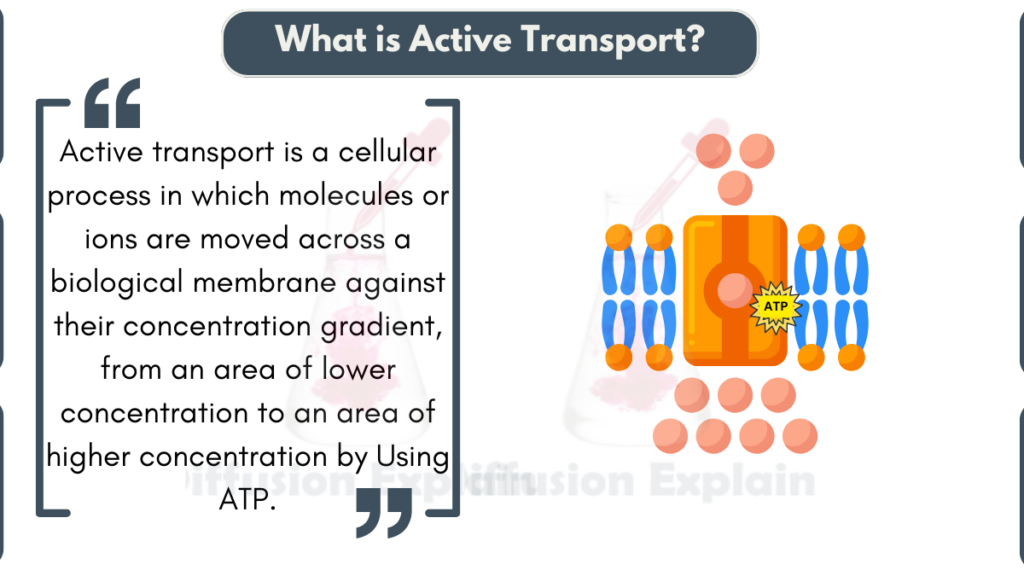
Active transport is necessary because some substances need to be concentrated in specific regions of the cell or across certain membranes, despite the natural tendency for molecules to diffuse from higher to lower concentrations.
Read about other Cellular Processes Simple Diffusion , and Facilitated Diffusion
Types of Active Transport
Active transport is a process where cells move molecules across their membranes against the concentration gradient, which means moving them from an area of lower concentration to an area of higher concentration. This process requires energy from the cell.
- Primary Active Transport
- Secondary Active Transport
What is Primary Active Transport?
Primary active transport directly uses cellular energy in the form of ATP (adenosine triphosphate) to move substances against their concentration gradient. This means pumping molecules into areas where they are already abundant, going against the natural tendency for molecules to diffuse from high to low concentration.
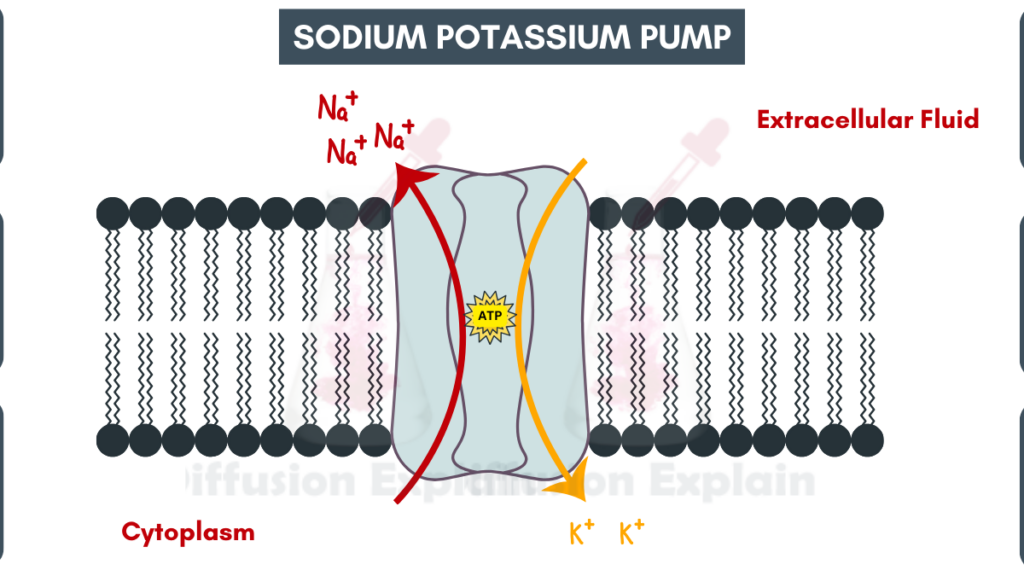
Types of primary active transporters include:
P-type ATPases
These are enzymes that directly utilize ATP to pump various ions across membranes. Examples include:
- Sodium-potassium pump – Maintains crucial ion balance in animal cells.
- Calcium pump – Regulates calcium levels in muscles and other tissues.
- Proton pump – Transports protons (hydrogen ions) across membranes, creating pH gradients vital for various processes.
F-ATPase
This enzyme complex is responsible for the synthesis of ATP, the energy currency of cells.
Mitochondrial ATP synthase – Generates ATP within mitochondria using the energy from the electron transport chain.
Chloroplast ATP synthase – Produces ATP in chloroplasts during photosynthesis using light energy.
V-ATPase
This type of ATPase pumps protons into specific cellular compartments like lysosomes and secretory vesicles, creating acidic environments necessary for their functions.
ABC (ATP-binding cassette) transporters
This is a large and diverse family of proteins that use ATP to move various molecules across membranes.
They typically have two parts – domains that bind ATP and hydrophobic regions that form a channel across the membrane.
They are involved in various processes like:
Exporting drugs and toxins – “MDR” (multidrug resistance) transporters help remove harmful substances from cells.
Nutrient uptake – “CFTR” (cystic fibrosis transmembrane conductance regulator) is involved in transporting chloride ions.
Example
An important example of primary active transport is the sodium-potassium pump, which is found in the membrane of animal cells. This pump actively transports sodium ions (Na+) out of the cell and potassium ions (K+) into the cell, maintaining the proper balance of these ions on each side of the membrane.
How Does it Work?
The process of primary active transport involves a specific type of protein called a carrier or pump protein. This protein is embedded in the cell membrane and acts like a molecular machine. When ATP binds to the protein, it causes the protein to change its shape, allowing it to bind to the molecule that needs to be transported (like sodium or potassium). As the ATP is broken down and releases energy, the protein then changes shape again, releasing the molecule on the other side of the membrane, against its concentration gradient.
What is Secondary Active Transport?
Secondary active transport is a process that uses energy stored in concentration gradients that were established by primary active transport. Instead of directly using ATP, secondary active transport takes advantage of these existing gradients to move other substances across the membrane against their own concentration gradients.
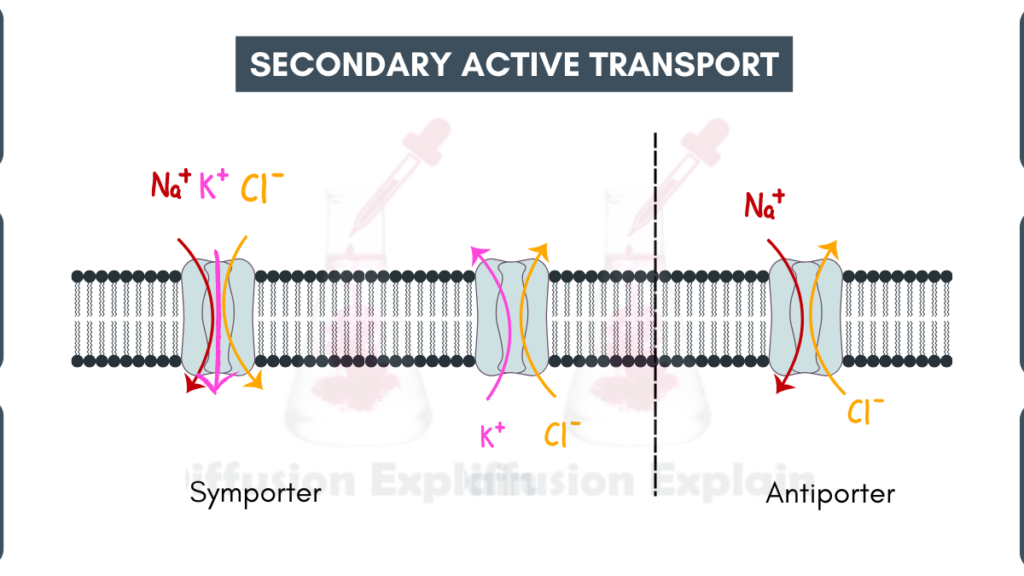
How Does it Work?
The process of secondary active transport involves two main steps:
- Primary active transport creates a concentration gradient by pumping ions (like sodium) out of the cell, resulting in a high concentration of those ions outside the cell and a low concentration inside. This establishes a “downhill” gradient for those ions to flow back into the cell.
- Secondary active transport takes advantage of this downhill flow. A special type of carrier protein acts like a “taxi” for another molecule (like glucose). As the ions (e.g., sodium) rush back into the cell down their concentration gradient, the carrier protein uses this movement as energy to simultaneously transport the other molecule (e.g., glucose) uphill, against its own concentration gradient.
Examples
There are two main types of secondary active transport:
Symporter: In this case, both molecules (the ion and the other molecule) move in the same direction across the membrane. For example, the sodium-glucose cotransporter in the intestine uses the downhill movement of sodium ions to transport glucose into the cell at the same time.
Antiporter: In this case, the two molecules move in opposite directions across the membrane. For example, the sodium-hydrogen antiporter in the stomach uses the downhill movement of sodium ions to pump hydrogen ions out of the cell, helping to create the acidic environment in the stomach.
By using the energy stored in concentration gradients created by primary active transport, secondary active transport allows cells to move a wide variety of important molecules across their membranes against their concentration gradients, without directly expending ATP.
Examples of Active Transort in Living Organisms
Here are some examples of active transport in living organisms:
1. Sodium-Potassium Pump
Sodium-Potassium Pump is found in animal cells. It actively transports sodium (Na⁺) out of the cell and potassium (K⁺) into the cell.
It uses ATP (cellular energy) to maintain a specific concentration gradient that is needed for nerve impulses, muscle contractions, and overall cell function.
2. Absorption of Nutrients in Small Intestine
Absorption of Nutrients in Small Intestine is another example of active transport in living organisms. Intestinal lining cells actively transport various nutrients like glucose (sugar), amino acids, and minerals against their concentration gradient.
Specific carrier proteins embedded in cell membrane bind to these nutrients and use the energy gradient created by the sodium-potassium pump to transport them into the bloodstream.
3. Uptake of Minerals in Root Hair Cells
Plants require essential minerals for growth and development. Root hair cells actively transport these minerals (like calcium and magnesium) from the soil into the plant against the concentration gradient.
Just like the small intestine, specific protein pumps use ATP or a process called co-transport, where the movement of one molecule (like hydrogen ions) helps the movement of another (like a mineral).
4. Secretion of Substances
Many cells actively transport substances out of the cell for various purposes.
Examples are:
- Salivary glands – Secrete digestive enzymes like amylase.
- Sweat glands – Release sweat to regulate body temperature.
- Adrenal glands – Secrete hormones like adrenaline.
Active transport mechanisms are employed in these processes to move the desired molecules against their concentration gradient.
5. Nerve Impulse Transmission
The electrical signals that travel along nerve cells rely heavily on active transport. The sodium-potassium pump maintains a voltage difference across the nerve cell membrane.
Controlled changes in ion permeability allow transmission of electrical impulses for communication within the nervous system.
